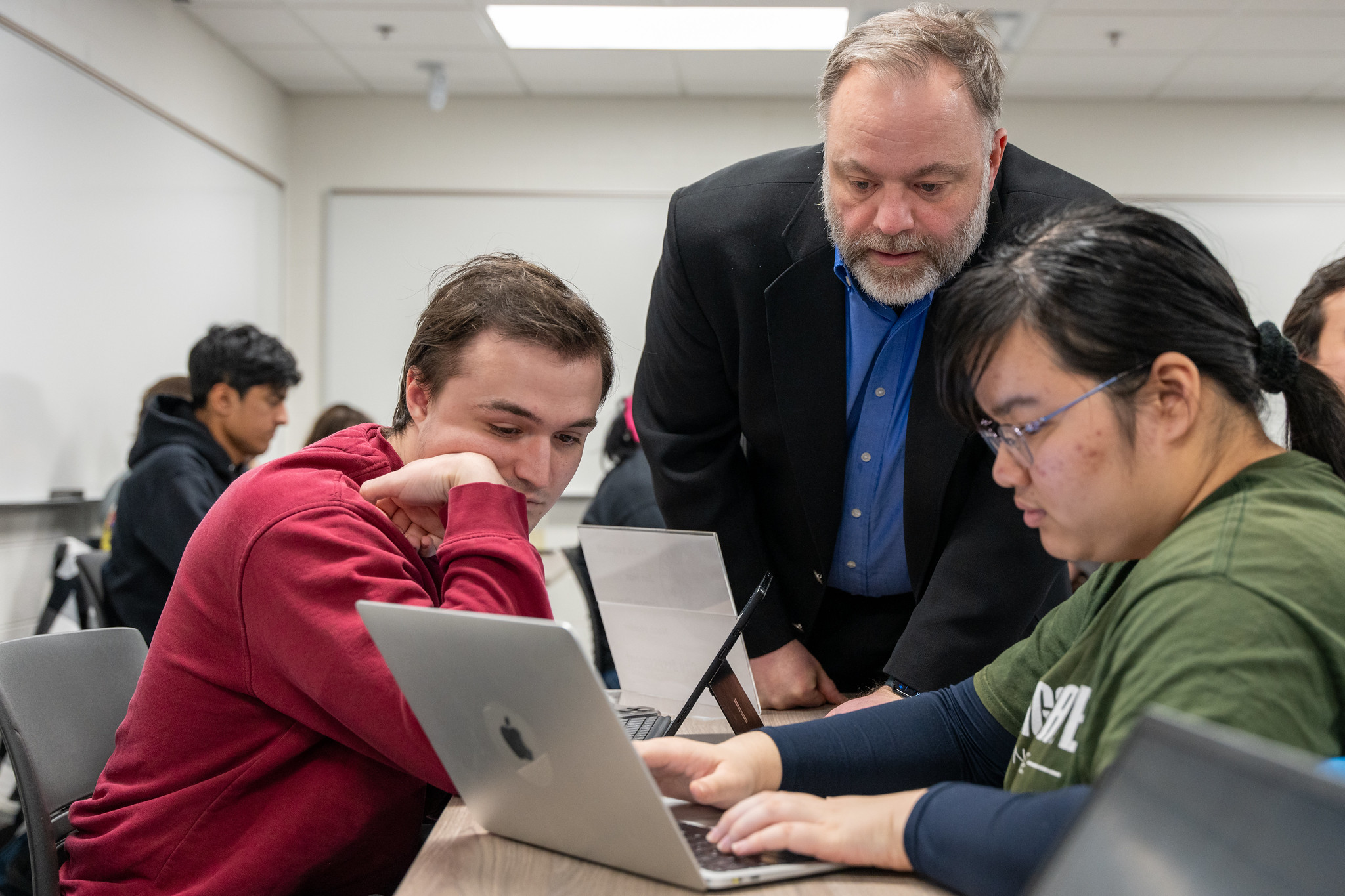From chemistry to coding, AI tools enhance learning at College of Natural Science
Faculty using AI to provide personalized feedback, prepare students for future

Melanie Cooper wants her chemistry students to learn to think like scientists.
The Michigan State University professor of chemistry and Lappan-Phillips Professor of Science Education believes students shouldn’t only memorize facts. Just as scientists do in the real world, students should construct models, analyze data and apply ideas to real-life problems.
Students aren’t likely to learn those skills studying for multiple-choice exams. Unfortunately, in large introductory-level courses, that’s historically been the only feasible option.
Now, generative artificial intelligence, or AI, is changing the game. Cooper is creating her own chatbot to offer students immediate, specific feedback on their homework and, eventually, tests. She’s adjusting her courses to teach students to become high-level thinkers, testing them on how well they connect the dots on what they’ve learned – answers they can’t easily find on Microsoft Copilot, ChatGPT or other generative AI.
Her goal is to push students beyond what was previously possible. Teaching the same old way could enable students to pass classes without ever learning the material.
“There’s a sea change coming, if we can take advantage of it and do this right,” Cooper said. “If we don’t, I think we’ll do ourselves out of a job.”
Time for change
Cooper and other College of Natural Science faculty are embracing generative AI as the future. They’re changing the way they teach to focus on problem-solving and connecting concepts. Some believe the new technology could be the catalyst students need to push past striving for good grades to instead focus on learning and critical thinking. Coding classes are teaching students not just how to write code, but also to write prompts to generate the code and check it for mistakes.
Dirk Colbry, senior specialist in the Computational Mathematics, Science and Engineering Department, believes faculty can’t afford to keep teaching as if generative AI doesn’t exist. Students can use generative AI as a crutch or as a tool. It all depends on how faculty teach their classes.
“My argument has always been that it isn’t going away,” Colbry said. “You can’t put the genie back in the bottle. We have to adapt or die. It’s just a matter of time before AI is even more advanced. It’s coming very quickly.”
Generative AI is the latest of many tools that have changed how classes are taught. Once upon a time, educators worried that calculators would become a crutch, and students wouldn’t learn math fundamentals. The dawn of the internet, then Google and Wikipedia, also brought hand-wringing that technology would spell the end of education.
In a way, the worriers were right, Colbry said. Students could use calculators and Google to easily find answers instead of memorizing facts. ChatGPT is likely to be more of the same.
But the answer isn’t to get rid of technology, Colbry said.
“Instead of saying ‘No, you can’t use that,’ we need to change our teaching model, and possibly our metrics,” Colbry said.

What does high-level thinking look like?
Colbry said he doesn’t teach programming the same way he used to because the field is forever changed. Generative AI can already effectively write code. What students really need to know is how to evaluate that code and check for mistakes.
For example, his assessments don’t ask students to write code. Instead, students are instructed to write a prompt for AI to generate code. Then, they explain how they knew the code was correct. Colbry might also show students an error message and ask them what it means and how they would fix it.
“We’re switching our learning goals away from spitting out knowledge and moving toward evaluating and testing,” Colbry said. “That is actually what we’ve always wanted to teach. It’s just that we couldn’t because we had to worry so much about the students getting the syntax right first. Now this lowers that barrier and makes for better students.”
A chatbot for large-classroom solutions
Until now, short-answer or essay assessments were only possible in small classrooms like Colbry’s. Classes designed to meet general education requirements typically have high enrollments, with lecture halls filled with hundreds of students. Grading short-answer tests for that many students was infeasible at best and impossible at worst. That’s why most teachers in those classes stuck to multiple-choice exams.
The problem is, in the real world, scientists don’t answer multiple-choice questions.
“I feel it sends a strong message to students that if you memorize these things and you learn how to do these calculations, you will get a good grade,” Cooper said. “But in fact that’s not particularly productive, and it doesn’t represent science. In science, we construct models and explain phenomena. We analyze data and ask questions.”
Cooper wanted to find a way to provide feedback to students and provide them with individual attention. She also wanted more data on which material her students hadn’t mastered so she could better understand what she should review further in class.
Last year, Cooper received a nearly $400,000 National Science Foundation grant to create and train a chatbot that will grade and comment on her chemistry students’ work. Students could also use the bot for help with their homework, getting answers not from the internet but from Cooper’s chemistry curriculum.
Joseph Krajcik, director of MSU’s CREATE for STEM Institute, is working on a similar project to support K-12 science teachers. They want their students to move from memorizing science to doing science, but the overwhelming workload it would add is a huge barrier. Generative AI has the potential to help students be familiar with applying science to real world problems before they ever step into a college classroom.
In the meantime, AI is already playing an integral role in Cooper’s courses. She used endowment funds to buy a retrieval augmented generative, or RAG, AI that’s a closed system, removing concerns about student privacy. Cooper’s experimenting with entering student homework responses into the system to get an instant snapshot of how well students understand the material.
Cooper also used AI to turn her chemistry textbook into a series of podcasts. These recordings aren’t audiobooks—they feature two cohosts talking about the class material in an engaging, fluid style. They sound just like a real podcast, except the hosts aren’t real. It’s another way to increase student learning with minimal additional work by faculty.
A time-saver
Stephen Thomas, digital curriculum coordinator for the College of Natural Science, said faculty are using AI like a personal assistant to save them time and energy. They’re asking chatbots to help them align their teaching objectives with their assessments. They’re scanning their tests for questions that are too advanced for the class material. AI is doing the thankless grunt work, allowing faculty to devote more time to teaching and research.
Thomas has also used AI for critical feedback on ideas, lesson plans and evaluations.
“One of the most powerful things is when you tell AI, ‘this is what I believe. Tell me where I’m wrong,” Thomas said. “It goes against confirmation bias and is also fairly emotionless.”
AI could be a game-changer for increasing accessibility. For example, a biology professor teaching the Krebs Cycle could load a lesson plan into a chatbot and ask how it should be modified for a person with blindness. The chatbot might suggest eliminating visual metaphors and trimming the text to avoid screen reader fatigue. The same lesson could also be easily translated to other languages.
“This idea that there could be a really robust customization based each person’s needs is just transformative,” Thomas said.
Preparing students for the future
Students who graduate from MSU will have AI at their fingertips. Just as the workforce has grown to depend on Google and the internet, the next generation of workers will be expected to use AI to increase efficiency and perform daily tasks.
Danny Caballero, Lappan-Phillips Chair of Physics Education, is also a principal investigator in the Physics Education Research and Computing Education Research labs. He's working to prepare students not just for using AI, but also for living in a world that’s impacted by the technology.
He and his colleagues are educating students on the right time and place to use AI, and how to use leverage it as a resource without circumventing their own learning. He wants them to think critically about their relationship to technology and view it through the lens of data science and machine learning.
Caballero also wants students to acknowledge the ethical problems plaguing the technology itself, such as implicit bias in the content it generates and energy consumption. He calls attention to problematic implementation, such as technology that alerts police to gunshots and might result in over-policing of black and brown neighborhoods.
This approach is challenging since generative AI has only been on the scene for a few years. Meanwhile, the technology’s capabilities have rapidly matured, making it a moving target. We’re only scratching the surface of knowing the implications of generative tech, he said. Faculty are scrambling to prepare students for a world that doesn’t yet exist.
“It’s really difficult because AI moves so quickly, and educational systems do not,” Caballero said. “The mismatch between them is what’s causing issues, because it’s not just students learning in our classrooms. It’s also, how do we organize ourselves to have a conversation with students about a world where AI is going to be a large part of their experience?”

- Categories: